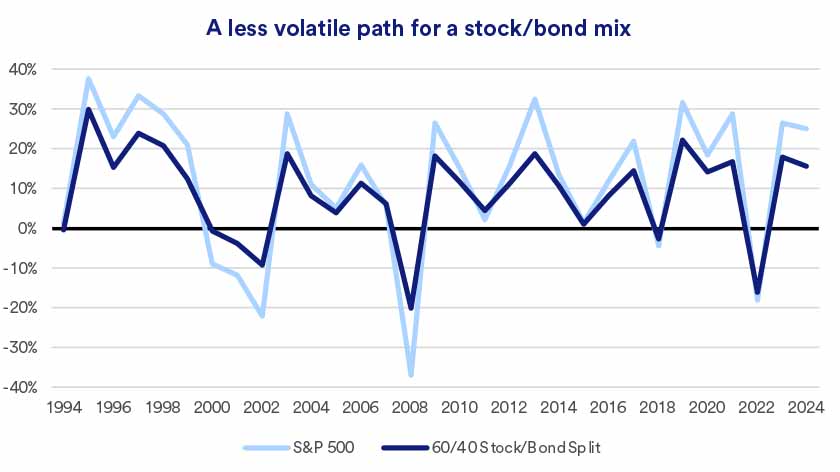
Key takeaways
While investors assessing their investment options often focus on an asset’s return potential, an equally important consideration is how to manage portfolio risk.
One key to managing risk is to follow the adage, “don’t put all your eggs in one basket.”
Diversification is the practice of building a portfolio with a variety of investments that have different expected risks and returns. The goal is to provide a smoother path for achieving your goals over time.
What is diversification strategy?
A diversification strategy is the process of putting money to work in a mix of assets with differing characteristics. Building your portfolio in an appropriately diversified manner can help spread the risk of negative performance in a specific investment or market segment, with the potential to enhance investment results.
No matter how strongly you feel about the prospects for a specific investment, a variety of factors can affect its performance. These could range from unforeseen economic changes (i.e., high inflation, a recession); changes in the competitive market landscape; or other factors that can impact a security-issuing business or entity. “Diversification means increasing the odds that your portfolio will contain some winners over a specific period,” says Rob Haworth, senior investment strategy director at U.S. Bank Asset Management. By owning different types of investments that typically generate varied performance across different environments, you can position your portfolio to be more resilient during challenging market periods. Over your investment time horizon, diversification can help provide a degree of stability to your portfolio. “Diversification is an answer to the reality that it’s impossible to know in advance which investments are going to be most successful over a given time period,” notes Haworth.
Why use a diversification strategy?
A diversification strategy can help protect you against circumstances that can negatively impact specific investments.
“In a typical environment, if the Federal Reserve is cutting interest rates to help spur a struggling economy, stocks may be encountering headwinds, but bonds tend to perform well as rates decline. We don’t always see stocks and bonds move in opposite directions, but it happens frequently.”
Rob Haworth, senior investment strategy director, U.S. Bank Asset Management
As an example, let’s look at industry-specific risk found in energy stocks. If the price of oil falls, your holdings in the oil and gas industry may see their share prices fall. If you’ve invested in other industries or other types of assets, the potential decline in energy stocks’ value may be offset by gains in other parts of your portfolio.
Diversification does not guarantee returns or protect against losses and can help mitigate some, but not all, risk. For example, systematic risks – which include inflation, interest rates or geopolitical events – can cause widespread economic and market instability, negatively affecting asset classes across a broad range.
Seven diversification strategies for your portfolio
1. Determine correlation
Correlation indicates the concurrent performance patterns of two securities or asset classes. It’s important to consider asset correlation as you structure your portfolio. For example, if you own many different investments that are positively correlated, it means they all are likely to trend up or down at the same time. In that event, while you may own different assets, your portfolio isn’t appropriately diversified. Consider, for example, that high-yield bonds are positively correlated with stocks. Therefore, a portfolio made up entirely of high-yield bonds and stocks is not effectively diversified.
“In a typical environment, if the Federal Reserve cuts interest rates to help spur a struggling economy, stocks may encounter headwinds, but bonds tend to perform well as rates decline,” says Haworth. “We don’t always see stocks and bonds move in opposite directions, but it happens frequently.”
Historically, a mix of stocks and bonds provides a level of diversification that can smooth investment performance. Less volatile returns over time can result from a portfolio featuring a combination of 60% stocks (based on the S&P 500) and 40% bonds (represented by the Bloomberg U.S. Aggregate Bond Index), compared to an all-stock portfolio. Maintaining more consistent performance year-over-year is likely to help individuals keep assets actively invested. “Staying invested in the market is important,” says Haworth. “Diversification that evens out performance over time helps investors keep money consistently invested.”

2. Diversify across asset classes
As an investors, your portfolio can be constructed utilizing several primary asset classes, including:
- Equities (stocks)
- Fixed income investments (bonds)
- Cash and cash equivalents
- Real assets including property and commodities
These asset classes tend to generate different returns and are subject to varying levels of risk. Including investments across asset classes is an important first diversification step. A diversified portfolio will include representation from at least two asset classes.
3. Diversify within asset classes
Further diversification is possible within asset classes. You can seek to diversify by:
- Industry: If you invest in energy stocks, for instance, consider adding tech, biotech, utility, retail, and other sectors to your portfolio.
- Fixed income investments (bonds): Look for bonds with different maturities and from different issuers, including the U.S. government and corporations.
- Funds: While some funds track the overall stock market (known as index funds), other funds focus on specific segments of the stock market. If your goal is diversification, check the types of securities in which your funds invest to make sure you’re not overly exposed to a specific investment category.
Even within an industry, it can pay to be diversified. “Some company-specific issues can arise that differentiate performance between two companies that are in the same industry,” says Haworth. He points to the recent performance of two prominent semiconductor stocks. “Nvidia has been a star performer in the market, while Intel is cutting back its workforce,” says Haworth. In 2024, Nvidia stock gained 171% while Intel stock was down 60%.1
4. Diversify by location
It’s also a good idea to consider global exposure as a part of your diversification strategy.
For example, if you only own U.S. securities, your entire portfolio is subject to U.S.-specific risk. Foreign stocks and bonds can increase a portfolio’s diversification but are subject to country-specific risks, such as foreign taxation, currency risks, and risks associated with political and economic development. However, in periods when U.S. stocks face headwinds, global markets may perform better. The appeal of global diversification, says Haworth, is that “ultimately, we are a global economy, and that should be reflected in a diversified portfolio.”
Location can also matter in terms of investments in tax-exempt municipal bonds. “Bonds issued by the state of Illinois and the city of Chicago have recently run into payment and credit problems,” says Haworth. “Investors based in a state trying to capitalize on state tax exemption of income generated by those bonds should also consider diversifying into bonds from issuers based in other states to protect against issuer risk.”
5. Explore alternative investments
If you’re seeking additional diversification, other types of assets should be considered:
- A REIT owns and operates properties, such as office buildings, shopping centers or apartment buildings. Owning shares in a REIT gives you the chance to receive a portion of the earnings of those businesses in dividends. Additionally, REITs are not strongly correlated with stocks or bonds.
- Commodities are investments in physical goods, from gold to natural gas to wheat and even cattle. You can buy commodities directly or through a commodity fund.
- Reinsurance as an investment is available as a pooled fund that provides coverage to back the risk carried by other insurers. Investors’ earnings are the result of premiums paid by the insured companies. “It’s an asset class where returns aren’t driven by the business cycle that impacts equities and bonds. Performance is often weather-related,” says Haworth.
6. Rebalance your portfolio regularly
Even the most diversified portfolio requires periodic rebalancing. Over time, certain investments will gain value, while others decline. Rebalancing is a negotiation between risk and reward that can help your portfolio stay on track amidst the market highs and lows.
There are certain situations that might trigger rebalancing, including market volatility and major life events. Read more about when to rebalance your portfolio.
7. Consider your risk tolerance
Your views about investment risk can impact your diversification strategy. Generally, the longer your investment timeframe, the more you can weather short-term losses and capitalize on the potential to capture long-term gains. There are a few questions that can help you determine your risk tolerance.
- Aggressive investors generally have time horizons of 30 or more years. With this flexibility, they have a higher risk tolerance and may allocate 90 percent of their money to stocks and just 10 percent to bonds.
- Moderate investors, who have approximately 20 years before they need their money, generally allocate a lower percentage to stocks than an aggressive investor. For example, they may have 70 percent of their funds in stock and 30 percent in bonds.
- Conservative investors — those who have little risk tolerance or will need their money in 10 or fewer years — may consider a 50/50 balance between stocks and bonds, and incorporate cash into their asset mix.
“In some cases, people can get overly aggressive with their asset mix compared to their actual risk tolerance,” says Haworth. “These are the investors who tend to take money out of the market during down periods, then are too hesitant to get back in and miss out on the market’s subsequent upside.” Haworth says investors need to try to realistically assess where they fall on the risk spectrum and invest appropriately based on that so they consistently keep money working in the market.
Build a diversification strategy that’s right for you
A diversification strategy is designed to help your investment portfolio generate more consistent returns over time and protect against market risks. Review your portfolio to determine if it's appropriately diversified for your financial goals, risk tolerance and time horizon.
Whether you want to invest on your own or with personalized financial guidance, we have investing options to meet your needs.
Tags:
Explore more
How diversification in investing may reduce risk
Why is diversification important in investing? Because risk never disappears—even in times of economic growth.
Personalized investing guidance aligned with your goals.
Let us help you craft a portfolio that reflects your goals, time-horizon and values.


